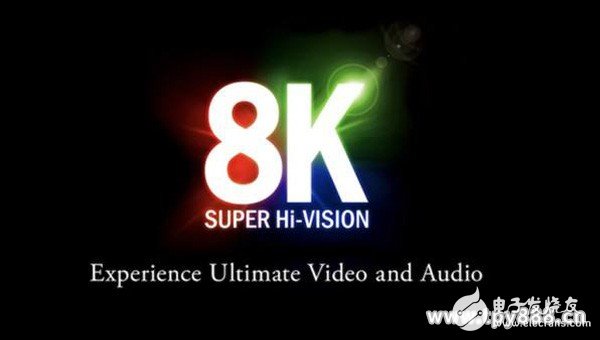Recently, the display industry has announced two major developments. The first is that IHS Markit estimates that 8K TV displays will make their market debut in 2018, marking it as the first year of 8K adoption. Ricky Park, director at IHS Markit, stated, "Since Ultra HD has quickly replaced Full HD in the large-screen TV market, panel manufacturers are now offering higher-resolution differentiated products. In 2018, we expect it to be the first year of 8K resolution TV displays."
Coincidentally, this year’s CES conference showcased several industry leaders entering a sleek mode, with a wide range of new technologies and products on display. Among these, 8K technology was the clear highlight. In recent years, there has been significant excitement around 8K. Although I haven’t even used 4K yet, I’ve become quite curious about 8K since Japan announced it would broadcast the 2020 Olympics using 8K signals.

The emergence of 8K brings great opportunities for the security industry. It is well known that higher resolution is an ongoing pursuit in this field. If 8K can be applied, it could bring a technological revolution. For the security sector, the most obvious benefit of high-definition technology is clearer images and more detailed visuals. These enhanced details align perfectly with the growing need for intelligent security solutions.
From a vendor perspective, clearer images and richer details offer greater analytical value, which translates into more market opportunities. With 8K, departments can share information more efficiently. There's no need to install multiple cameras to cover different areas within the same scene, which helps reduce costs. It also allows for a more accurate reconstruction of real-world details. Even during unexpected events, different departments can use the same camera to identify points of interest. After multi-stage zooming, high-definition details can still be captured clearly.
This means 8K technology can be effectively used in applications like smart cities, highways, airports, and train stations. However, is 2018 really the first year for 8K? Is the time right for its widespread application, especially in the security industry? To answer these questions, we should first examine the basis of IHS Markit's prediction that 2018 will be the first year of 8K TV display adoption.
According to market data, ultra-high-definition panels already accounted for over 98% of the 60-inch or larger display market in 2017. IHS reports that in 2018, TV panel suppliers plan to mass-produce 8K (7680x4320) displays, making up about 1% of the market. By 2020, this is expected to rise to 9%. Thus, 2018 is projected to be the first year of 8K TV display commercialization.
IHS analysts noted that due to the popularity of UHD in the large-screen TV market, panel manufacturers are increasing the availability of higher-resolution products to capture premium segments and maintain profit margins.
On the supply side, the data supports this prediction. In 2017, the China Taiwan Group began developing 8K panels and launched the first 8K LCD TV display in the fourth quarter of that year. These screens were initially supplied to Sharp and Chinese brands. Sharp also produced the first 70-inch 8K LCD TV in the same quarter. In 2018, Samsung and Sony are expected to drive the 8K market, while BOE and CLP Panda are planning to develop 8K LCD panels in the second half of the year.
Based on these developments, especially from leading display companies, it seems that 8K is just around the corner. However, the commercialization of a new technology isn't just about technical advancements. While we don't discuss video sources or transmission in the consumer market, applying 8K in the security industry presents unique challenges.
8K usage involves the entire industry chain, from lenses and sensors to encoding, storage, and backend display devices. Only when all parts of the chain support 8K can it have real application potential. Despite some progress in storage and encoding, back-end decoding and display devices still face limitations. Additionally, the high bandwidth required for transmission and the physical pixel constraints of display devices remain significant hurdles.
Even 4K, which is already in use, still faces issues like high bandwidth, increased storage needs, and high bit rates. So, the transition to 8K is not easy. The security industry must address these challenges before full-scale implementation becomes feasible.
Cost is another major issue. Implementing 8K technology means sharper surveillance images, which result in larger video files. This requires more advanced transmission technology and higher bandwidth, leading to network upgrades and increased storage demands. Massive data storage, efficient querying, node load balancing, and backup systems are all critical but challenging aspects that need to be addressed.
Market acceptance is also a big hurdle. While people desire clearer images, the market is not always quick to adopt new technologies. The previous generation of 4K technology took years to stabilize, and even today, it still faces many unresolved issues. Consumers and businesses alike focus on price-to-performance ratios. They aren't eager to jump on the next tech bandwagon without clear benefits. For manufacturers, the challenge is to make 8K affordable and accessible, which takes time and effort.
In conclusion, while 8K technology is advancing rapidly and many are optimistic about its commercial prospects, a more rational analysis shows that it's still too early to talk about its full application, especially in the security industry. However, this doesn't mean we dismiss the value of 8K. The human desire for clearer images is endless, and the trend toward higher definition in the security industry is inevitable. Though 8K commercialization may take time, it's clear that the future of security is heading in this direction—though not necessarily in 2018.
Power Supply for Industrial Equipment,industrial power supply 24v,1200W Power Supply Adapter
FOSHAN SHUNDE KELICHENG POWER SUPPLY TECHNOLOGY CO., LTD , https://www.kelicpower.com
